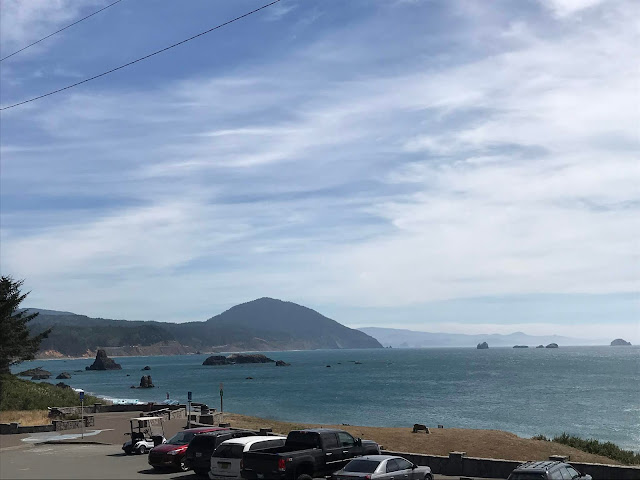The Sturgeon Moon rose high above the evergreens and cast its
light upon the rippling river below. Pickup trucks with boats on trailers signaled
the activity of the day. They were out early to put their jet boats in the water
and capture their favorite spots before anyone else.
 |
| Dawn on the Lower Rogue |
As I opened the patio door and walked out onto the covered deck, a Stellar Jay that had come to visit flew from the railing.
Down from the deck and rounding the cabin corner, the smell of bacon being cooked on an outdoor grill brought back
memories of campfires and wilderness of many years gone by.
Gold Beach is on the Pacific coast and approximately 45 miles north of the California-Oregon state line. About 25-30 miles inland and northeast of Gold Beach and near the confluence of two wild and scenic rivers, the Lower Rogue and the Illinois, is a place called Agness.
Friends were camping here and asked us to join them for a few days of salmon fishing. Cabins were available for rent and with a great view of the river_ a beautiful place, relaxing and allows for the rejuvenation of one's soul.
You listen to the quiet except for the distant hum of the boat motors. If you choose to see what the outside world is doing, internet service is available if you walk to the office, but that was not on my list of to-dos.
Normally Steelhead (a sea-run rainbow or redband trout) are born in the river,
stay until they’re around 7 inches long then head downstream to the ocean where
they stay for several years while getting bigger and stronger and then return to spawn. While we were there, the majority of the fish caught were
half-pounders, except for one Chinook.
Half-pounders are unique to
the Rogue, Klamath, and Eel rivers. They are 'bomerang' steelhead, homebody
fish that don't wander far from their natal rivers. Like most steelhead,
half-pounders smolt when they are about seven inches long and head for the
ocean, usually between March and May. But instead of waiting two or three years
before they return, the half-pounders come back to the Rogue the next fall,
even though they are not sexually mature. Some may stay in the river another
year, feeding like trout, before heading out again. Others return to the ocean
in spring. And the next fall they're back as mature steelhead. . .
The typical
half-pounder is 12 to 16 inches long (and often weighs more than half a pound.)
When they first return in the fall, they are aggressive and readily take a fly.
After a few weeks in the river, they feed like trout again and can provide good
fishing when pursued with winter fly-fishing techniques. Hatchery clips the
dorsal fins and you can’t keep those on the half-pounders.


 |
| Hawthorne Gallery, Port Orford, OR |
 |
| heading up the mountain from Gold Beach |
 |
| Klondike fire |
 |
| Dry campers all along the river as we head back down the mountain |
 |
| early morning |
 |
| campers set up for evening of food, fun, and fellowship |
 |
| children playing and learning to fish |
 |
| half-pounders |
 |
| Catch of the day_ wild Chinook |
|
|
 |
| the boys are going out |
 |
| CA campers have come prepared |
 |
| cabins, tents, and rv's |
 |
| Prime filleting, he said |
 |
| vacuum sealed and in the freezer |
Beautiful and a most enjoyable trip it was.











































